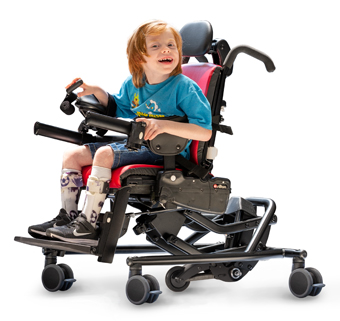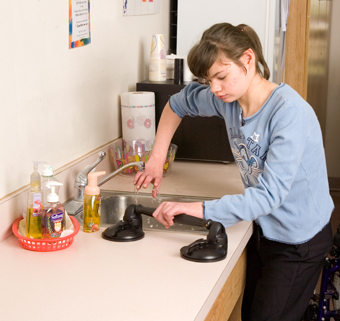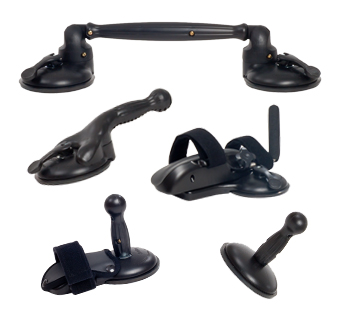Correct Positioning in the Rifton Chair
| January 2012
Update (January 2019): Good news for those who have been wishing for the old Rifton Compass Chair… A newly redesigned Compass Chair is available now.
Update: The classic wooden Rifton chair (Rifton Toddler positioning chair) much loved by classroom teachers and therapists for its simple look and basic positioning options has now been replaced (and radically upgraded) by the Rifton Activity Chair. The Rifton Activity chair has the unique versatility to convert from a supportive positioning chair to a simple classroom-style chair with the necessary boundaries and comfort. In addition, each chair size has growth to accommodate a wide variety of body shapes and sizes. Learn about the features and benefits of Rifton’s newest seating line or check out the related resource on correct positioning in the Rifton Activity Chair.

In the catalog it is called the Rifton Toddler Chair, but most people refer to it as just “The Rifton Chair.” The Rifton Chair is part of a family of seating from Rifton which includes Activity Chairs. Because of its newness and “celebrity status,” many of our posts have been dedicated to the Activity Chair. But the Rifton Chair has seniority. It has been around for ages and is still utilized for positioning in the classroom, daycare, and clinic. So today’s post will be dedicated to the Rifton Chair and the opportunities it provides for seating and positioning children with mild disabilities.
The Rifton Chair is best described as a basic positioning chair. It was designed to give younger (toddler aged) children chances to be included in a circle time or table activities with their peers. With this in mind, the wooden frame and soft colored accessories of the Rifton Chair blend naturally into surroundings decreasing emphasis on the disability or differences of the child.
Active Participation with the Rifton Toddler Chair
 But let’s face it, positioning children with even mild to moderate disabilities can be difficult especially when behavioral issues are involved. It is important to realize that the Rifton Chair provides boundaries and to utilize the prompts in a way that give a child a sense of security without feeling trapped as this will make them act out even more. Sometimes just the firm back and raised sides of the chair provide this needed security. Or maybe using the back and seat pads and adding cushioning to the sides of the Rifton Chair can do the job. The trick is not to overdo the supports. The less you can get away with the better, as this allows the muscles of the body to activate and independently support postures in the Rifton Chair. Speech Language Pathologist, Elizabeth Ward, shares how she uses the Rifton Chair for therapy purposes:
But let’s face it, positioning children with even mild to moderate disabilities can be difficult especially when behavioral issues are involved. It is important to realize that the Rifton Chair provides boundaries and to utilize the prompts in a way that give a child a sense of security without feeling trapped as this will make them act out even more. Sometimes just the firm back and raised sides of the chair provide this needed security. Or maybe using the back and seat pads and adding cushioning to the sides of the Rifton Chair can do the job. The trick is not to overdo the supports. The less you can get away with the better, as this allows the muscles of the body to activate and independently support postures in the Rifton Chair. Speech Language Pathologist, Elizabeth Ward, shares how she uses the Rifton Chair for therapy purposes:
The beauty of the Rifton Chair is its simplicity and low profile support system for a wide variety of users. This includes those children who may have behavioral challenges in addition to their physical disabilities.
"Children with sensory needs cannot sit for long periods of time without boundaries. The Rifton toddler chair provides this needed input. The Rifton chair is used frequently for children who have feeding aversions and delays. The chair and abduction block provide optimal positioning so the child is able to sit up at a 90 degree angle to have appropriate head and neck alignment. Feeding positioning for children is essential to ensure safe feeding without signs and symptoms of aspiration.
As a speech-language pathologist of over 3 ½ years I have always relied on Rifton toddler chairs for safety and optimal speech, language and feeding development. Parents frequently are impressed with the increased attention span and compliance with children in therapy sessions. Rifton chairs are wonderful for at home use and to use for carry-over from therapy. As a speech-language pathologist I quite often refer parents and caregivers to Rifton products.”
As with all adaptive devices for children with special needs, it is critically important for caregivers to recognize the positioning purposes of straps and support prompts. These positioning aids should never be used for restraint. For more information on the use of straps and prompts for positioning, read the statement put together by Karen Pierz, PT Concerning Appropriate Use of Straps and Supports with Rifton Products.




